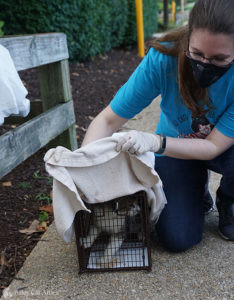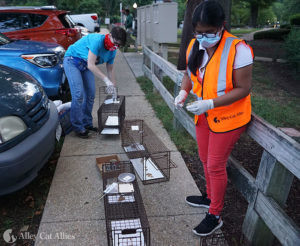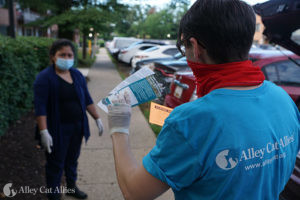
Charlie the community cat trapped on his colony site in Maryland during an Alley Cat Allies TNR initiative. He was then neutered, vaccinated, eartipped and returnedall with special COVID-19 safety protocols.
Though the COVID-19 crisis has presented many new challenges to our work as cat advocates, we’re a movement of doers who aren’t afraid to innovate. We are adapting rapidly and creating new best practices to continue to help cats during the pandemicincluding with Trap-Neuter-Return (TNR).
With careful planning, coordination, and attention to pandemic safety measures, helping community cats with TNR is more than doable, even in these difficult times.
Last month, Alley Cat Allies set out on a TNR initiative to help caregivers reach the last few cats in a colony living around an apartment complex in Maryland.
Here’s how we did it, and how you can, too. We’ll walk you through how we planned the initiative, how we connected with spay and neuter services, how our team maintained social distancing, and the modified COVID-19 veterinary protocols we encountered.
Planning Ahead (Yes, Keep Feeding Cats!)
As we detail in our Step-By-Step Guide to Trap-Neuter-Return (available at alleycat.org/TNRGuide), the first thing to do in TNR is to plan out every step in the process. In this case, we started by recruiting help from a caregiver and establishing a feeding aschedule.
Since the beginning of the pandemic it has been allowable and safe to feed community cats. Just make sure to maintain social distancing every step of the way. In fact, feeding cats on a schedule is critical to TNR. If cats know they’ll find a meal they form a habit of coming out to a certain place at a certain time. That makes your trapping life much easier!
We provided one of the apartment complex caregivers with cat food and advised her to feed the cats every morning around 5:30 a.m.except the day before trapping and on trapping day itself. That way, the cats were hungry and enticed by the food in the traps.
Check Local COVID-19 Recommendations
Check your local COVID-19 statistics regularly to see if your area is experiencing an increase in cases. If so, consider taking extra precautions or research mask mandates in veterinary clinics or other indoor areas.
Finding a Spay and Neuter Clinic
The second step to any TNR effort is making sure you have a veterinarian who is ready and waiting to spay and neuter every cat you trap. Many people who care for cats have discovered that the COVID-19 crisis has reduced access to spay and neuter services. That’s why this should be one of the first tasks on your list.
In Hyattsville at the time we trapped, local high-volume clinic was closed. So we turned a private veterinary practice that is a Feral Friends Network® member. We confirmed how many spay and neuter slots were available for cats and planned around that quantity when we set our traps.
Since many low-cost, high-volume clinic are closed during the pandemic, we recommend that you branch out, call around, and research to find another clinic in the areaor maybe one a little further away. You may be able to find a clinic through our Feral Friends Network by searching at alleycat.org/FindFeralFriends. Many clinics are beginning to open again for spay and neuter, so keep checking back if your first attempt is unsuccessful.
You can also consider private veterinary practices. Since these practices may not be familiar with TNR, you can share with them our veterinary resources, including our spay and neuter protocols. Be clear up-front about what services you’ll needsuch as eartippingand what services you won’t needsuch as pre-operative bloodwork, or FIV and FeLV testing. You may also be able to request a discount. Remember, your work as a caregiver is important and TNR benefits the community!
When you find the spay and neuter services you need, be sure to ask about any new COVID-19 safety protocols so you can prepare to follow them. Protocols may include curbside drop off, contactless check-in, or mandatory mask-wearing and social distancing.
After our team lined up everything up with the clinic, we gathered our TNR equipment and headed over to the apartment complex.
Consider Megestrol Acetate (MA)
It may well be that a spay and neuter appointment cannot be obtained in a timely fashion, especially for female cats who could become pregnant at any time.
In these cases, ask your veterinarian about Megestrol Acetate (MA) as a non-surgical contraception option. MA is recommended as a short-term contraceptive during the pandemic by the Alliance for Contraception in Cats & Dogs (ACC&D).
Learn more about MA at alleycat.org/Contraception
COVID-19 Safety Equipment and Social Distancing
As with everything in this strange new world we live in, we urge you to think safety first, safety second, and safety third throughout TNR.

Alley Cat Allies staff and volunteers decked out in COVID-19 safety gear while setting traps for our TNR initiative in Maryland.
When we arrived to start trapping bright and early on a July day, we had plenty of masks to protect our staff and caregiversand we did not take them off. When doing TNR on your own, check local and state health advisories to determine where and when you should be wearing a mask. Our team also wore gloves at each step and had spare pairs to change into. We included plenty of hand sanitizer in our updated trapping kit for even more protection.
Our team made sure to maintain social distancing even while setting up and baiting traps. No one ever came within six feet of each other. If you go trapping with a buddy, which we always recommend, keep in mind that you must also social distance in the field if you don’t live in the same household.
Educating the Public from Six Feet Away
We weren’t on our own for long as we continued trapping cats. Curious neighbors came over to ask what we were up to, which happens frequently during TNR. We needed a hands-off way to answer their questions so we all could stay safe.

Alley Cat Allies’ bright orange social distancing handout helped streamline community relations during our TNR effort in Maryland.
We planned ahead for this, too, which is why we had our new Social Distancing Handouts for TNR on hand. These free, printable cards allow you to easily explain TNR and its benefits while maintaining that critical space that keeps us all safe.
Our method was simple: We politely asked folks to keep their distance, placed the card and other educational resources on the ground or other convenient surface, then backed away so they could approach and pick them up. When they had questions, we answered them, keeping our distance while doing so.
You can download your own copies of the handouts at alleycat.org/SocialDistancingHandout.
New Era, New Veterinary Protocols
We’re happy to report that our trapping day was very successful. We trapped all the cats we set out to trapCharlie, Danni, and Mamaand maintained COVID-19 safety measures all the while. We loaded the cats in their traps into our transport vehicle and headed over to the clinic.
Like most veterinary clinics, things are not quite “business as usual” at the veterinary hospital. Rather than walking through their doors to wait in the lobby, all clients enjoy curbside service for the sake of social distancing.
When we arrived, we stayed in our car in the parking lot and called the front desk to tell them we were ready and waiting. A staff member came out to meet us and walk us through the paperwork and intake process. Then they took the cats inside for the next leg of their journey. Our team and the veterinary staff had masks firmly on at every step.
Pickup was just as easy the next day. We simply called, waited in our car, and had the catsall now spayed and neutered, vaccinated, eartipped, and microchippedbrought out to us. These protocols not only allow us to continue saving cats’ lives during the pandemic but ensure we as caregivers and advocates are as protected as possible.
The Return, and the Big Picture
There’s nothing quite like the moment of returning a community cat to her outdoor home, knowing she will thrive because of your help.
As we knelt to open the traps’ doors and watched Charlie, Danni, and Mama dart out, we felt even better knowing we had improved their lives while protecting the wellbeing of our trapping team.
We know we’re not alone. Alley Cat Allies has been developing special COVID-19 protocols like these for caregivers and advocates, knowing that our shared desire to help animals has not decreased in any way. In fact, it is stronger than everand we want to support that compassion while upholding safety.
Get Vaccinated to Save Lives
If you have not received the COVID-19 vaccine, we strongly recommend you do so as soon as possible. Getting vaccinated will protect you, your familyincluding its animal membersand the cats and kittens you care for.
You should know:
- Cats CAN contract COVID-19 through contact with infected people. When you are vaccinated, they are safer.
- In addition to adhering to local mandates, keep informed about the COVID-19 threat in your area. If COVID-19 cases are rising where you live, consider taking extra precautions.
It is a top priority that every one of us do what we can to protect our individual health, the health of loved ones, and the health of the wider community. It is also critical to continue our efforts to help cats in our communities through important approaches like TNR.
This walk through our Hyattsville trapping effort was about showing you a few new tricks and tools you can use your critical work for cats. We can’t wait to see how you put them into action.
View our COVID-19 Response Hub at alleycat.org/Coronavirus to find all our resources, more stories from the field, and stay up to date on the best practices for ourselves and for cats as the pandemic continues.


